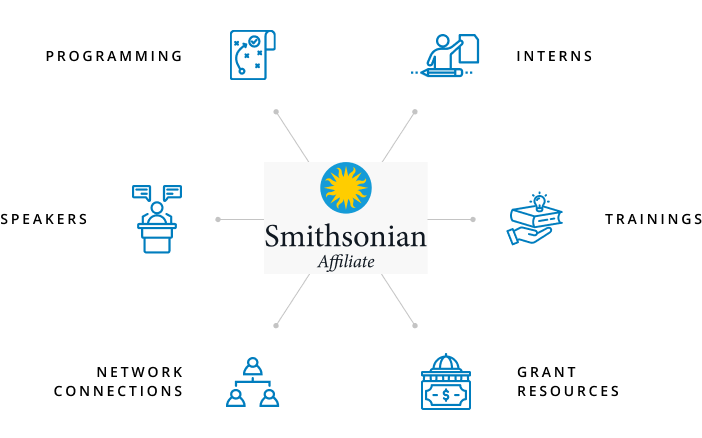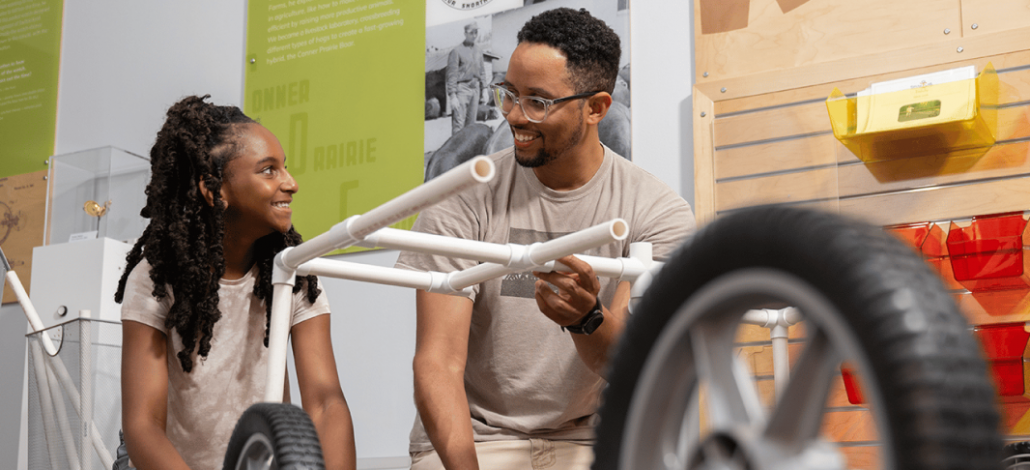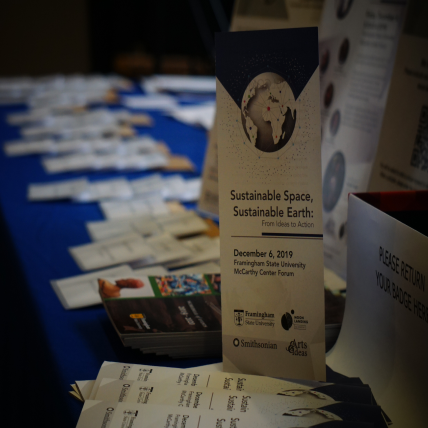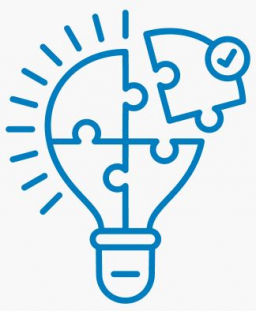Leveraging & Marketing: Making the Most of Being a Smithsonian Affiliate
![]()
Museum
![]()
Topics
Big Ideas
How Affiliation can unlock access to resources for local communities
How Affiliates market and socialize the Affiliation

The Smithsonian is more than just an education program or an exhibit. It’s larger than that. It’s resources that are administrative, resources for best practices, and resources for the things that we never think of. It really is a toolbelt.

The Museum of Flight
AFFILIATE PERSPECTIVES
Going beyond the logo:
What the Affiliation offers
While a great starting point for the Smithsonian Affiliations is using the Smithsonian logo on your institution’s website and the decal on your door, seasoned Affiliates emphasize going far beyond the logo.


CONNER PRAIRIE
Interns, Training, Programming
At Conner Prairie, being an Affiliate means finding every possible way to link our local museum back to the content and expertise of the Smithsonian in DC. “We have multiple levels of engagement,” says Norman Burns, Conner Prairie President, and CEO. “Our Smithsonian internship program allows participants to work with our collections and museum experience staff in an AAM accredited and a Smithsonian affiliated museum,” says Burns. “Conner Prairie staff participate in and present at the Smithsonian Affiliate conferences and workshops, as well as, with partnering organizations like the International Coalition of the Sites of Conscience and Made By Us”.
For the larger and more visible programming initiatives indoors and outdoors we have collaborated with the Smithsonian on Spark!Lab and the Habitats exhibit as ways to fulfill our missions to “inspire curiosity and foster learning,” says Burns. Developed by the Smithsonian’s Lemelson Center for the Study of Invention and Innovation at the National Museum of American History, Spark!Lab focuses on inspiring inventiveness in children through hands-on activities – “a perfect fit,” according to Burns.
Conner Prairie is one of only ten Spark!Lab sites across the country. Unlike other locations, Conner Prairie worked with a local design team to create a stand-alone experience connecting local youth to how Indiana’s history plays a role in invention.
Due to the closing of the main museum experience center for renovation and expansion in February 2024, Conner Prairie is now working with Smithsonian staff on how to best relocate Spark!Lab across the site in multiple locations to demonstrate how innovation exists everywhere.
Conner Prairie’s Research and Evaluation team is collaborating with the Smithsonian on the development and deployment of an evaluation toolkit to better equip Smithsonian Affiliates and Spark!Lab partner sites with the tools necessary to perform effective formative and summative evaluation.
Being part of a global research institution like the Smithsonian allows our staff to better understand and connect with Conner Prairie’s aspirational goal to change the way the world views and uses museums.

Conner Prairie
FRAMINGHAM STATE UNIVERSITY
Smithsonian Speakers
At the Christa McAuliffe Center for Integrated Science Learning at Framingham State University, Dr. Irene Porro, Director, sought to commemorate the 50th anniversary of the moon landing in 2019. Porro worked with her National Outreach Manager, Jennifer Brundage, and the Smithsonian Affiliations office to arrange a full line-up of speakers.
“I couldn’t imagine just a one-day event,” says Porro. “I organized an 18-month long series with events every month, with speakers, to explore the historical, social, and cultural context of the moon landing. We had historians and social scientists, people talking about climate change. We talked about the Civil Rights Movement and the Women’s Movement. It all concluded with a one-day symposium with speakers talking about sustainability on planet Earth and in space. At least half of the speakers were from the Smithsonian.”
“As a university without facility space, it’s about the scholars and experts, not the artifacts and exhibits,” says Porro. “I don’t know if many people realize that there are a lot of researchers affiliated [with Smithsonian]. These are some of the strongest, most powerful resources, even beyond the artifact.”


Bringing the global resources of the Smithsonian to our local communities is an important part of being an affiliate,” says Burns. “Most people will never leave a region and visit the Smithsonian in DC, so the affiliates allow the Smithsonian’s content and objects to arrive at the doorstep of their local communities and engage guests in a familiar setting.

Conner Prairie
Unlocking access to Smithsonian resources for your local community
Many seasoned Affiliates have developed deep relationships with their National Outreach Manager. Some of the most compelling examples of impact lie in finding ways to bring Smithsonian resources, be they speakers, programs, objects, or remote tools, to their local community. For many, unlocking access to the Smithsonian is one of the most exciting and meaningful aspects of the Affiliation.

Bringing Daytime Astronomy to Local Kids
Dr. Irene Porro of the Christa McAuliffe Center at Framingham State University points to the MicroObservatory Robotic Telescope Network, a collection of robotic telescopes built for the public to observe the sky.
Through MicroObservatory, young learners can operate telescopes remotely. “I love doing that because when we work with community-based organizations, we do not have access to all the resources traditional amateur astronomers would have,” says Porro. The original program allowed children in under-resourced neighborhoods of Boston to participate in real-time astronomy, even in the afternoon, by requesting nighttime astrophotos from the Smithsonian—this unlocked conversations about processing the science behind the images.
“We really value this,” says Porro. “What the tool offers is for anyone to do astronomy, even if you are doing it during the day. It’s all remote, and it gives access to a deeper exploration of the night sky to individuals who otherwise would not have access.” Porro cites that as the MicroObservatory tool has continued to evolve in format to become more and more accessible, the Smithsonian has made it available to them to continue integrating the new versions of the tool into their programs.

Smithsonian Storytelling Made Local
Conner Prairie’s example of bringing the SITES exhibit Habitat developed by Smithsonian Gardens to central Indiana is demonstrative of how the breadth of the Smithsonian story can be integrated into the stories and environment of the local community. “This exhibit is an excellent fit for Conner Prairie, which has 1,046 acres of land and 3.3 miles of river to tell a story about the connection of the local environment on a global scale,” says Norman Burns, President and CEO. The Habitat exhibit is currently incorporated into Conner Prairie’s certified outdoor classroom that includes Treetop Outpost and the River Lookout and will be incorporated into a new 2.4-mile White River trail system opening in the spring
of 2024.
The flexible, scalable, and build-it-yourself exhibition approach allowed our Conner Prairie design and fabrication team to work with five local artists to design and create eye-catching 3D elements to compliment twelve thematic sections with meaningful interpretation from the global to the local story. “Connecting local artists to a Smithsonian exhibit is a great example of Smithsonian storytelling made local,” says Burns.
AFFILIATE ADVICE
Learning all the ways the Affiliation can serve you
01
To make the most of the Affiliation, build a relationship with your National Outreach Manager
Across the board, our seasoned Affiliates advise building a relationship with your National Outreach Manager and continuing a spirit of brainstorming and bidirectional conversation.
“A direct result of the Affiliates conference was, we were talking about how to make a museum more accessible to audiences with disabilities,” says Seth Margolis, Director of Education Operations at The Museum of Flight. “Rather than trying to go through non-museum partners, Laura [their National Outreach Manager] linked us up with Access Smithsonian. That jumping-off point of, there’s already a museum thinking about this; let’s partner with them and get those resources.”
”Part of it is showing up for the conference, getting to build that relationship with your regional partner,” says Devon Akmon, Director at the Michigan State University Museum.

02
Reach out to your National Outreach Manager when you may need outside input or resources
When asked for advice on the right moment to reach out, Margolis says, “It’s when you think it’s going to need an outside partner or outside voice or the resources of organizations that have done some of these things before. Where we want to get some input, we’ll talk to Laura; maybe she has some ideas. Maybe she’ll get us in touch with another Affiliate. It’s amplification, not just through the Smithsonian, but through the
Affiliate network.”
Above all, Affiliates recommend not overthinking it and keeping an open conversation with your National Outreach Manager. “First and foremost, just make the call or send the email about the resource needed,” says Burns. “It all starts with sharing the idea to open up the dialogue to see what they think and how they can work with us to accomplish the goal.”
Never assume that it’s going to cost you money or a significant amount of money. “There are many things that Conner Prairie does like our youth summits and internships where the Smithsonian has helped with the funding of the program activity,” adds Burns. “We are always excited with the ideas that are shared by the Affiliate office and who they connect us with in the Smithsonian system to help solve a problem, provide content or partner on a program.”

03
Invite Affiliation staff to your site
National Outreach Managers play a critical role in making the most out of Affiliations and they visit every new Affiliate during the onboarding phase to welcome Affiliates to the community and share more about the relationship with staff and board members. Spending time with your National Outreach Manager and helping them understand your experience on the ground creates fertile ground for partnership and collaboration in the future. Conner Prairie routinely invites their National Outreach manager Aaron Glavas to visit and understands the impact of this meaningful connection. “This allows him to meet with staff and share ideas that further connect our institutions. By walking around the site, he further engages in our museum operations and programming experience. This process sparks ideas about other ways that we could connect naturally with the Smithsonian,” says Burns. Additionally, National Outreach Managers can play a meaningful role in your institution’s major milestone events and exhibition openings.

AFFILIATE ADVICE
Marketing and socializing the Affiliation
01
Maximize use of the logo—as long as it's approved first
At a baseline, most Affiliates include the Smithsonian Affiliations logo on their website and the decals on their front door. “When we invite a Smithsonian curator to Pittsburgh, we make a big deal of that in our earned media, whether it’s newspaper, television, radio,” says Andy Masich, CEO of the Heinz History Center. “We make a big deal of our Smithsonian Affiliation. In any publication, we show both [Heinz and Smithsonian logos.”
Smithsonian Affiliations encourages using the Smithsonian logo but requires approval before using it. Note that the logo cannot be used for direct fundraising. Talk to your National Outreach Manager to understand the situations in which the logo can be used.
02
Consider offering two-in-one memberships
Smithsonian Affiliations offers a benefit where Affiliates can sell two memberships in one—the Affiliate’s organizational membership combined with a Smithsonian membership. In doing so, Affiliates often earn revenue and offset the Affiliation fee or programming costs. The Heinz History Center, an Affiliate since 1999, has offered this “two-in-one” membership since becoming an Affiliate. “That Smithsonian brand helped strengthen our own brand,” says Masich.

03
Socialize the relationship with a one-pager
“The logo is great,” says Devon Akmon, Director of the Michigan State University Museum. “But where it really resonates is when we talk about the totality of what that relationship looks like, then the repeated socialization of that.”
Akmon recommends creating a one-pager that includes past, recent, and upcoming work with Smithsonian and encapsulates your organization’s relationship with the Institution. In his past role at another Affiliate, Arab American National Museum, Akmon created a two-sided overview covering exhibit, programming, and thought leadership in association with Smithsonian. “Everywhere I go, I do the same thing right away,” says Akmon. “Here are the five things we’re doing at this time with Smithsonian and the really cool things we’re doing next year. I want this in the development packet.”
See below to download examples as of July 2023.


It’s about creating direct access for the local community to something much larger. The Affiliates program helps us find ways to bring a behemoth national organization like the Smithsonian and incredible local organizations together to create access and get people connected to the collective human experience and stories from the national to the local stage.

Conner Prairie
Learning Excursions
Take a deeper dive into what it means to be an Affiliate through these Learning Excursions. Use filter controls below to access content by type.

Essentials
Geared towards new and existing Affiliates, access modules to assess your organization’s:
- DEAI
- Community Engagement
- Vision for Engagement
- Collaboration and Relationship Building

Affiliate Stories
Modules to enhance your collaborative efforts, build leadership skills, and showcase your impact. Here you’ll find:
- Case studies
- Affiliate perspectives

Tools for Action
To facilitate ongoing learning and skill development, find:
- Reflection guides
- Toolkits
- Other resources
We’d love to hear from you!
Do you have a powerful story of successful community engagement or collaboration you’d like to share? Or do you want to connect and learn more about community engagement resources and supports?
Reach out to your National Outreach Manager. They’d love to connect and share ideas!


|
Mailing Address PO Box 37012 MRC 942 Washington, DC 20013-7012 |
Delivery Address 600 Maryland Avenue SW Suite 5060W Washington, DC 20024 |
Phone Smithsonian Affiliations: (202) 633-5300 SITES: (202) 633-3168 Museum on Main Street (202) 633-5335 |
SITES: Museum on Main Street: Smithsonian Affiliations: |
